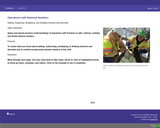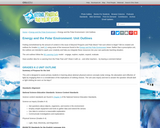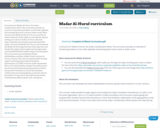
Students learn how to add, subtract, multiply, & divide fractions and decimals.
- Subject:
- Mathematics
- Numbers and Operations
- Material Type:
- Activity/Lab
- Assessment
- Homework/Assignment
- Author:
- Rob Robinson
- Date Added:
- 07/09/2019

Students learn how to add, subtract, multiply, & divide fractions and decimals.

This article assembles free resources from the Arctic and Antarctic Birds issue of the Beyond Penguins and Polar Bears cyberzine into a unit outline based on the 5E learning cycle framework. Outlines are provided for Grades K-2 and 3-5.

This unit consists of five lessons covering buoyancy and engineering boats. Each lesson includes goals, anticipatory set, learner objectives, guided practice, procedure instructions, closing activities, and extensions. Student handouts and worksheets are also included.
Lesson 1: Intro to Buoyancy
Lesson 2: Engineer a Barge
Lesson 3: Intro to Sails & Motion
Lesson 4: Engineer a Sailboat
Lesson 5: Final Vessel
NGSS: 3-5-ETS1-1, 3-5-ETS1-2, 3-5-ETS1-3
Lesson 1 materials: empty 2-liter bottles with tops cut off, pennies or other coins, marble, modeling clay, crap wood, rocks, pingpong ball, golf ball, popsicle stick, paper clip, scale, other object for floating or sinking
Lesson 2 materials: for each student - 12" x 12" piece of aluminum foil, 4 popsicle sticks, 2 straws, 12" masking tape; teacher pre-setup - enough pennies for testing (500 pennies per group), pool filled 2/3 with water
Lesson 3 materials: string/yarn, 1/2 straw for each student, 2 different types of paper (tissue & white copy paper), tape, scissors, fan, wooden skewers, 2 popsicle sticks per student, rulers, protractors, stencils.
Lesson 4 materials: 8 popsicle sticks, 1 wooden skewer, 1 straw, masking tape or duct tape, tissue paper or copy paper
Lesson 5 materials: same as Lesson 2

This article assembles free resources from the Energy and the Polar Environment issue of the Beyond Penguins and Polar Bears cyberzine into a unit outline based on the 5E learning cycle framework. Outlines are provided for Grades K-2 and 3-5.

The 11th grade learning experience consists of 7 mostly month-long units aligned to the Common Core State Standards, with available course material for teachers and students easily accessible online. Over the course of the year there is a steady progression in text complexity levels, sophistication of writing tasks, speaking and listening activities, and increased opportunities for independent and collaborative work. Rubrics and student models accompany many writing assignments.Throughout the 11th grade year, in addition to the Common Read texts that the whole class reads together, students each select an Independent Reading book and engage with peers in group Book Talks. Students move from learning the class rituals and routines and genre features of argument writing in Unit 11.1 to learning about narrative and informational genres in Unit 11.2: The American Short Story. Teacher resources provide additional materials to support each unit.

This unit uses William Shakespeare’s Much Ado About Nothing as a vehicle to help students consider how a person is powerless in the face of rumor and how reputations can alter lives, both for good and for ill. They will consider comedy and what makes us laugh. They will see how the standards of beauty and societal views toward women have changed since the Elizabethan Age and reflect on reasons for those changes. As students consider the play, they will write on the passages that inspire and plague them and on topics relating to one of the themes in the play. Finally, they will bring Shakespeare’s words to life in individual performances and in group scene presentations.
ACCOMPLISHMENTS
Students read Shakespeare’s Much Ado About Nothing .
Students read two Shakespearean sonnets and excerpts from an Elizabethan morality handbook dealing with types of women, and they respond to them from several different perspectives.
For each work of literature, students do some writing. They learn to write a sonnet; create a Prompt Book; complete a Dialectical Journal; and write an analytical essay about a topic relating to a theme in the play.
Students see Shakespeare’s play as it was intended to be seen: in a performance. They memorize 15 or more lines from the play and perform them for the class. Students take part in a short scene as either a director or an actor.
GUIDING QUESTIONS
These questions are a guide to stimulate thinking, discussion, and writing on the themes and ideas in the unit. For complete and thoughtful answers and for meaningful discussions, students must use evidence based on careful reading of the texts.
What are society’s expectations with regard to gender roles?
Does humor transcend time? Do we share the same sense of humor as our ancestors?
How do we judge people?
How important is reputation?
BENCHMARK ASSESSMENT (Cold Read)
During this unit, on a day of your choosing, we recommend you administer a Cold Read to assess students’ reading comprehension. For this assessment, students read a text they have never seen before and then respond to multiple-choice and constructed-response questions. The assessment is not included in this course materials.
CLASSROOM FILMS
The Branagh version of Much Ado About Nothing is available on DVD through Netflix and for streaming through Amazon. Other versions are also available on both sites.

In this lesson, the performances continue. The final group of students will perform their memorized passages from Much Ado About Nothing .

The unit is focused on the examination of geography in terms of “place.” Students dive into inquiry to answer the compelling question, What is unique about living in Washington? Through this question students will understand where and why people live in Washington State. Students will dive into the regions of Washington State and define it through many characteristics. Students will ultimately choose a region to become an expert on and communicate what makes that region unique. Each student’s performance task product will reflect choice and build upon student strengths according to their skill set.

Curriculum for Madar Al-Huruf, the Arabic transliteration wheel. This curriculum provides an overview of introducing students to the Arabic alphabet and teaching them how to write in Arabic script.
More resources for Madar Al-Huruf:
You can access the Q wheel workbook, which walks you through the steps of writing your name in Arabic, for free at this link: https://almasdar.oercommons.org/authoring/6042-madar-al-huruf-workbook/view
You can also download the Madar Al-Huruf app from the iTunes app store and Google Play: https://itunes.apple.com/mx/app/madar-al-huruf/id717596929?l=en&mt=8
About the developers:
The curriculum was developed by Fatima Abdulkadhem and Nour Jandali, Arabic teachers in Tucson, Arizona.
This unit was made possible through support and funding from Qatar Foundation International, LLC (QFI). A not-for-profit organization, QFI is a U.S.-based member of Qatar Foundation and is focused on grant-giving and programmatic activities that promote education as a force that facilitates collaboration across geographical, social and cultural boundaries. To learn more about QFI and the Arabic Transliteration Wheel, please visit: www.qfi.org.

In this mini-unit, students learn basic vocabulary about insurance and then play an online game called “That’s a Bummer” to practice knowledge learned. Additional activities in this lesson include an insurance edpuzzle, video resources, reflection questions, and an insurance math worksheet.
Class Time Needed: 4 to 5 Class Periods

This module provides a TABLE as a reference for each SUPERLesson, and aligns each unit to the specific NGSS it covers.

A 2nd grade STEM unit on biodiversity. Students will learn about habitats and their biotic and abiotic components and needs to create and implement a plan/device to increase the biodiversity of the urban school garden.

This article assembles free resources from the Polar Explorers issue of the Beyond Penguins and Polar Bears cyberzine into a unit outline based on the 5E learning cycle framework. Outlines are provided for Grades K-2 and Grades 3-5.

A middle school teacher uses class projects to introduce students to the principles of insulation.

This Remote Learning Plan was created by Joanna Pruitt as part of the 2020 ESU-NDE Remote Learning Plan Project. Educators worked with coaches to create Remote Learning Plans as a result of the COVID-19 pandemic.*I have remixed this lesson to use for a 9-12 grade research paper class. The only changes I made were to break it up into smaller sections (Topic Selection and Brainstorming) in order to fit it into our course schedule.

Students overlay USGS topographic maps into Google Earth’s satellite imagery. By analyzing Denali, a mountain in Alaska, they discover how to use map scales as ratios to navigate maps, and use rates to make sense of contour lines and elevation changes in an integrated GIS software program. Students also problem solve to find potential pathways up a mountain by calculating gradients.

This unit consists of five lessons encouraging younger learners to engineer increasingly better towers using blocks and recycled materials. Each 30 minute lesson ("phase") includes goals, discussion, activity instructions, extensions, and student worksheets.
Phase 1: Paper Cut-Outs Activity
Phase 2: Building Blocks Activity
Phase 3: Number of Blocks Activity
Phase 4: Building within a Space Activity
Phase 5: Recycled Tower Activity
NGSS: K-2-ETS1-1, K-2-ETS1-2, K-2-ETS1-3
Common Core ELA: RI.2.1, W.2.6, W.2.8, SL.2.5
Common Core Math: MP.2, MP.4, MP.5, 2.MD.D.10

Worksheet with worked-out problems on unit conversation, from Barbara Gilbert at CNM.

This Remote Learning Plan was created by Joanna Pruitt as part of the 2020 ESU-NDE Remote Learning Plan Project. Educators worked with coaches to create Remote Learning Plans as a result of the COVID-19 pandemic.The attached Remote Learning Plan is designed for Grades 9-12 English Language Arts students. Students will learn the research process and how to write a research paper. It is expected that this Remote Learning Plan will take students 4-5 weeks to complete.

The Web-based Inquiry Science Environment (WISE) is a free on-line science learning environment for students in grades 4-12. In WISE, students work on exciting inquiry projects on topics such as genetically modified foods, earthquake prediction, and the deformed frogs mystery. Students learn about and respond to contemporary scientific controversies through designing, debating, and critiquing solutions, all via the internet. Curriculum projects are complete and ready to use in the classroom. The projects are designed to meet standards and complement existing science curricula. The Teacher Area lets instructors explore new projects and grade students' work on the web, as well as to collaborate with other teachers and researchers.